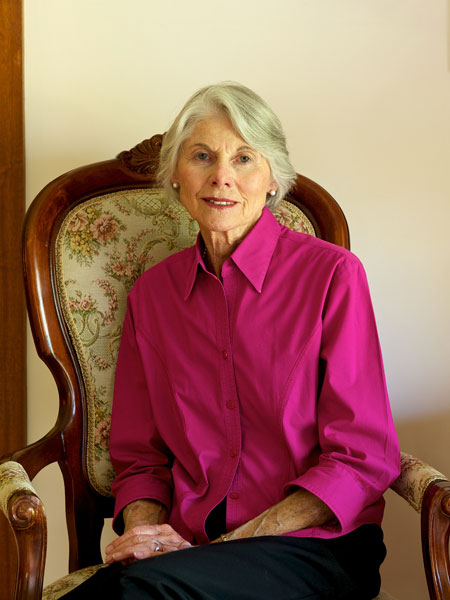Spring Hill – Margaret Edwards

Sitting there in the church I realised how significant this was in the soul of the village of Spring Hill. The village and surrounding farms always felt like a complete unit where all we needed was available and everyone knew everyone. It had a heart.
Margaret Edwards
I grew up at Trevanson near Spring Hill – the property settled by my Great-Grandfather, George Bishop May Senior in 1888, later the property of my father and mother, Jack and Helen. Jack continued working Trevanson with his father until his father retired to live in Orange in 1943. Meanwhile my sister Diana and I were born in 1940 and 1937 respectively.
My memories of life in Spring Hill revolve around the school. I started there when six years old. Mr Williams was the teacher. It was a one-teacher school with students from first class through to eighth class in the one room.
Memories of school include riding my bike home four miles in the middle of the day when the end of the war was declared in 1945, because the schools were granted a holiday for the rest of the day to celebrate. In following days we scraped the protective paper strips off the school room windows. This special paper had been pasted on in a chequered pattern as a requirement in war time. Also in war time I remember soldiers from the Army camp set up in Spring Hill coming to Trevanson to tend a 5 acre crop of lettuce my father had planted to help with supplies at the Army camp.
In the village there were two baker’s shops, the butcher’s shop, two general stores and the Post Office. I remember buying sweets on the way home from school with threepence. There was a sweet counter in each of the Post Office, Mrs Fettle’s little general store, Caruthers’ general store and at Mrs and Mr Hooper’s shed. I shopped at the latter – they didn’t seem to mind how long it took me to decide how to spend my threepence! The Methodist Church on the hill had an appointed minister living in the village parsonage and was well supported by the village people and district farmers. Regular services were conducted here. There was also a little Anglican church (now a home) and Catholic church (closed in early days and the building removed).
The Davis family had a dairy on the edge of the village and provided fresh milk for the residents. I believe most of the village residents worked around the district or on the railway in track maintenance.
The village and surrounding farms always felt like a complete unit where all we needed was available and everyone knew everyone. It had a heart. Everyone supported activities in the Temperance Hall and at the school (annual picnic days, sports days etc), the ladies bringing along generous contributions of food. We had a Globite suitcase we called the food port. My Mum would make several cakes or cake and biscuits for the occasion – as did others.
The school now includes demountable and is a significant aspect of the village. The Post Office and hotel remain active but all other businesses have closed. There are many newer homes. My childhood belongs to Trevanson and Spring Hill.
Recently I attended the Pleasant Sunday Afternoon of music at the Uniting Church in Spring Hill (which was originally the Methodist Church). Sitting there in the church I realised how significant this was in the soul of the village of Spring Hill. While we didn’t attend church every Sunday (as my forebears did) we supported the church and participated in associated activities. Significantly, my thoughts and feelings on this occasion were inspired by the involvement of those present in their church and in the community. Many of them are the descendants of those involved in this church of my youth and represent the fourth and fifth generation of the early settlers who lived in Spring Hill and district. They have welcomed and involved the many newcomers to the village and the district throughout the years. Together, these folk represent the heart in the village – the village of my heart.
Interviewed by Alex Rezko







